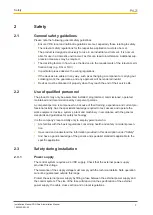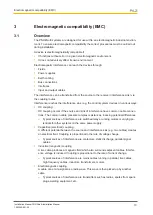
Electromagnetic compatibility (EMC)
Installation Manual PNOZmulti Installation Manual
1002265-EN-02
12
}
Cables of the same group can be laid within the same cable duct.
}
Cables from group 1 and group 2 should be laid in separate groups or in cable ducts
which are at least 10 cm apart.
}
Cables from group 1 and group 3 should be laid in separate groups or in cable ducts
which are at least 50 cm apart.
}
Data and signal lines should be laid as close as possible to an earthed surface.
Cabling to open air systems
}
As far as possible use metal conduits. These should be electrically connected and
earthed.
}
Ensure there is sufficient protection against lightning by using metal conduits earthed at
both ends, or concrete cable ducts with reinforcements connected across the joints.
3.2.3
Connecting the fieldbuses
To connect the available fieldbus systems, please refer to the
}
Operating manual for the respective fieldbus module.
}
Guidelines published by the user group or manufacturer of the respective fieldbus.
}
"Communication interfaces PNOZmulti" document
3.2.4
Equipotential bonding
Potential differences can occur if the devices are connected to different earth or ground
connections. Even cable shields that are connected at either end and have different earth
connections can cause potential differences. In order to avoid interference, equipotential
bonding cables must be installed. Please note:
}
Select a low impedance equipotential bonding cable.
}
Select the following as standard values for the cross section of the equipotential bond-
ing cables:
–
16 mm
2
for equipotential bonding cable up to 200 m in length
–
25 mm
2
for equipotential bonding cable over 200 m in length
}
If the devices of the control system PNOZmulti are connected with shielded signal
cables which are earthed at either end, the impedance is calculated as follows:
–
Impedance equipotential bonding cable = 10 % of shield impedance
}
Use copper or galvanised steel equipotential bonding cable.
}
Connect equipotential bonding cables to the earth bar over as wide a surface area as
possible.
}
As short a distance as possible should be kept between the equipotential bonding cable
and signal cable.
3.2.5
Shielding
Interference currents must be diverted to cable shields via shield bars.
Please note:
}
Connect the shields with low impedance to the shield bar or earth bar.
}
Use cables with a braided shield, with a minimum coverage of 80 %.













































